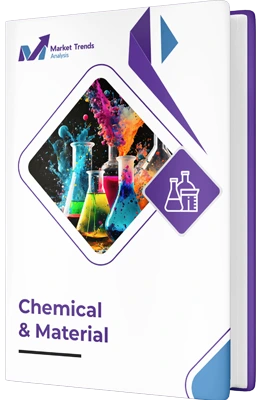
The 2D Chromatography Market was valued at USD 1.2 billion in 2024 and is projected to reach USD 2.4 billion by 2033, growing at a compound annual growth rate (CAGR) of approximately 8.5% from 2025 to 2033. This growth is driven by increasing demand for high-resolution analytical techniques across pharmaceuticals, environmental testing, and food safety sectors. The expanding adoption of industry-specific innovations and automation in laboratory workflows further accelerates market penetration. Regulatory pressures for precise contaminant detection and quality assurance are also pivotal in shaping market dynamics. As industries prioritize accuracy and efficiency, 2D chromatography is emerging as a critical tool in advanced analytical applications.
2D Chromatography is an advanced analytical separation technique that involves the sequential application of two different chromatographic methods to achieve enhanced resolution of complex mixtures. It allows for the separation of analytes based on two distinct physicochemical properties, significantly improving sensitivity and selectivity compared to traditional one-dimensional chromatography. This technique is particularly valuable in analyzing complex biological samples, environmental pollutants, and intricate chemical formulations. By providing a multidimensional approach, 2D chromatography reduces co-elution issues and enables detailed characterization of trace components. Its integration with mass spectrometry further amplifies its capability for comprehensive qualitative and quantitative analysis.
The 2D chromatography market is witnessing rapid evolution driven by technological innovations and expanding application scopes. Increasing integration with high-resolution mass spectrometry is enhancing analytical capabilities, fostering more precise detection of trace compounds. The adoption of automation and miniaturization is streamlining workflows, reducing analysis time, and improving reproducibility. Growing regulatory requirements for contaminant monitoring and quality control are prompting industries to adopt more sophisticated separation techniques. Additionally, the rising focus on personalized medicine and biomarker discovery is expanding the use of 2D chromatography in clinical research. The convergence of data analytics and machine learning is also enabling smarter, more predictive analytical processes.
The primary drivers propelling the 2D chromatography market include the escalating need for high-resolution separation techniques in complex sample analysis and stringent regulatory standards across industries. The pharmaceutical sector’s demand for precise drug purity and biomarker identification is a significant catalyst. Rising investments in R&D activities aimed at discovering novel compounds and personalized therapies further fuel adoption. Additionally, technological advancements in instrument sensitivity, speed, and automation are making 2D chromatography more accessible and efficient. Growing awareness of environmental pollutants and food contaminants is also compelling industries to adopt more robust analytical solutions. Overall, the convergence of technological innovation and regulatory compliance is creating a fertile environment for market expansion.
Despite its growth prospects, the 2D chromatography market faces several challenges. High capital and operational costs associated with sophisticated instrumentation can hinder widespread adoption, especially among small and medium enterprises. The complexity of method development and data interpretation requires specialized expertise, limiting user accessibility. Additionally, the lack of standardized protocols across laboratories can impact reproducibility and regulatory acceptance. Rapid technological obsolescence and the need for continuous training further add to operational hurdles. Moreover, competition from alternative analytical techniques such as high-performance liquid chromatography (HPLC) and mass spectrometry alone can restrict market growth. Addressing these restraints is crucial for broader market penetration and sustained growth.
The evolving landscape of analytical science presents numerous opportunities for the 2D chromatography market. The increasing emphasis on regulatory compliance and quality assurance in pharmaceuticals and food industries creates a sustained demand for advanced separation techniques. The burgeoning field of personalized medicine and biomarker discovery offers new avenues for application. Additionally, the integration of 2D chromatography with digital data analytics and artificial intelligence can unlock smarter, predictive analytical solutions. Expanding into emerging markets with growing industrial bases and regulatory frameworks can significantly enhance market reach. Innovations in miniaturization and automation are poised to reduce costs and complexity, broadening accessibility. Lastly, environmental monitoring and sustainability initiatives are driving demand for sensitive, high-throughput analytical tools.
Looking ahead to 2026 and beyond, the 2D chromatography market is set to revolutionize analytical science through its integration with cutting-edge technologies such as machine learning, IoT, and automation. Its application scope will expand into personalized medicine, real-time environmental monitoring, and rapid food safety testing, enabling industries to meet stringent regulatory standards with unprecedented precision. The future will see the development of portable, user-friendly 2D chromatography systems that democratize access to high-resolution analysis across diverse sectors. As industries increasingly prioritize data-driven decision-making, 2D chromatography will serve as a cornerstone for smart laboratories, facilitating faster, more accurate insights into complex sample matrices. This evolution will position 2D chromatography as an indispensable tool in the era of Industry 4.0, fostering innovation and regulatory compliance worldwide.
2D Chromatography Market was valued at USD 1.2 billion in 2024 and is projected to reach USD 2.4 billion by 2033, growing at CAGR 8.5% from 2025 to 2033.
Demand for high-resolution, multidimensional separation in complex matrices, Stringent regulatory standards for pharmaceuticals, food, and environment, Increasing R&D investments in drug discovery and personalized medicine, Technological advancements in automation and instrument sensitivity, Growing awareness of environmental and food safety concerns, Market penetration strategies targeting emerging economies are the factors driving the 2D Chromatography Market.
The Top players operating in the 2D Chromatography Market Agilent Technologies, Shimadzu Corporation, Waters Corporation, Thermo Fisher Scientific, Bruker Corporation, LECO Corporation, PerkinElmer Inc., JASCO Corporation, Knauer Wissenschaftliche Geräte GmbH, Sciex (a division of SCIEX), VWR International, Gerstel GmbH & Co. KG, Advanced Analytical Technologies, Phenomenex Inc., Bio-Rad Laboratories.
2D Chromatography Market is segmented based on Technique Type, End-User Industry, Application Area And Geography.
The sample report for the 2D Chromatography Market can be obtained on demand from the website. Also, the 24*7 chat support & direct call services are provided to procure the sample report.